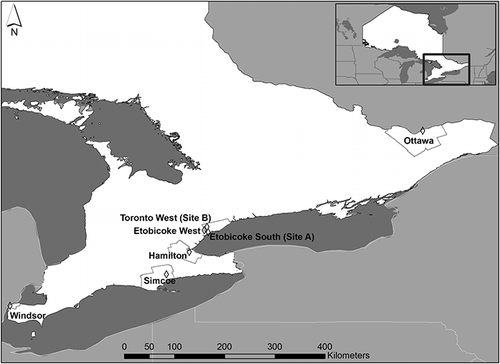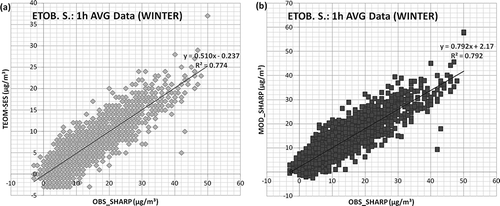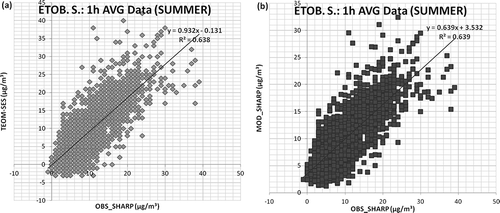Abstract
Tapered element oscillating microbalances equipped with sample equilibration system (TEOM-SES) used by the province of Ontario for the ambient monitoring of PM2.5 (particulate matter with an aerodynamic diameter ≤2.5 µm) in its air quality index (AQI) network were collocated with the Synchronized Hybrid Ambient Real-time Particulate monitor (SHARP 5030) at two monitoring sites for a period spanning approximately 2 years to determine the similarities and differences between the measurement outputs of both instrumental systems. Due mainly to mass loss observed with the TEOM-SES in cooler months, the province has recently switched its PM2.5 instrumentation at all stations in its monitoring network from the TEOM-SES to the SHARP 5030, which has the U.S. Environmental Protection Agency (EPA) Federal Equivalent Method (FEM) Class III designation. Thus, it has become imperative to develop corrections for historical and future TEOM measurements for the purpose of making them more agreeable to the new FEM method. This work details the authors’ multiple linear regression analyses (MLRAs) of particulate matter data from both instrumental monitors, with the inclusion of operational parameters of physicochemical relevance for both cases of transformations of historical TEOM and TEOM measurements to be made in the future. For historical TEOM data, it was observed that the transformations only benefited winter and fall months. Furthermore, comparisons of the transformed historical TEOM data with PM2.5 concentrations determined from the Federal Reference Method (FRM) sampler at seven locations within the province showed marked improvements over the observed TEOM-FRM comparisons.
Implications:This work provides a path to correcting the historically observed underreporting of particulate mass in winter and fall in Ontario by making the TEOM-based continuous data resemble the new FEM outputs (in this case, more SHARP-like). It is possible that the transformation of mainly winter TEOM data as detailed in this work may potentially lead to revisions in historical annual composite mean PM2.5 concentrations and total annual number of days PM2.5 exceeded the Canada-wide Standard (CWS) metric across the province.
Introduction
Tapered element oscillating microbalance (TEOM) technology was developed for continuous real-time measurements of particulate matter (CitationPatashnick and Rupprecht, 1991) and is widely used across North America. Since 2002, the TEOM equipped with sample equilibration system (TEOM-SES series 1400AB; Thermo Fisher Scientific, Franklin, MA, USA) had been used in Ontario for continuous monitoring of ambient fine particulate matter (aerodynamic diameter ≤2.5 μm; PM2.5) at its air quality index (AQI) and research stations (CitationEnvironmental Monitoring and Reporting Branch, Ontario Ministry of the Environment, 2013). Loss of semivolatile species have, however, been reported with TEOM instruments (CitationTortajada-Genaro and Borras, 2011). Previous studies indicate that PM2.5 measurements by the TEOM are found to be lower than those by the Federal Reference Method (FRM) during relatively cold periods and places, largely due to the loss of semivolatile components of PM2.5 (CitationRizzo et al., 2003; CitationZhu et al., 2007). This loss relative to the FRM may be mitigated by use of two TEOM sensors in a differential set up (CitationLee et al., 2005). In January 2013, Ontario replaced all TEOM monitors with the Synchronized Hybrid Ambient Real-time Particulate monitor (SHARP 5030; Thermo Fisher Scientific). The SHARP 5030 was deemed a suitable replacement for the TEOM-SES instruments, having obtained the U.S. Environmental Protection Agency (EPA) Class III Federal Equivalent Method (FEM) continuous PM2.5 monitoring designation in 2009 (EPA, 2011). The Ontario Ministry of the Environment (OMOE) now exclusively reports its AQI PM2.5 sub-index, annual composite mean PM2.5 values, and the PM2.5 Canada-wide Standard (CWS) metric based on the SHARP 5030 PM2.5 ambient concentrations. Most TEOM-SES instruments have been removed, with collocation of both instruments planned at only eight monitoring locations in the province for research purposes.
Thus, it is useful to develop transformations where possible for historical and future TEOM measurements so as to make them more agreeable to the new FEM method. Correcting pre-2013 data gives a better understanding of the underreported mass in winter. The AQI network in Ontario extensively uses telemetry to collect near-real-time concentrations of particulates to monitor ambient air quality levels. Other associated parameters of operational significance from the monitoring stations are collected as well. The work detailed herein is a multiple linear regression analysis (MLRA) of PM2.5 data from both instrumental platforms, with the inclusion of those additional parameters of physicochemical relevance for making historical and future TEOM-SES values more “SHARP-like.” It is expected that the “SHARP-like” transformed TEOM-SES concentrations should offer better linear relationship upon comparisons with 24-hr PM2.5 concentrations determined from the FRM than the originally observed TEOM-SES values if the MLRA is to be considered useful.
Rizzo et al. assumed a temperature “knot” and applied MLRA to temperature, TEOM-generated PM2.5 concentrations, and the interactions of these two variables to make TEOM data more “FRM-like” (CitationRizzo et al., 2003). In this study, we included all available operational variables in the MLRA to determine their significance at a given confidence interval and surmised that there may be physicochemical relationships within the TEOM- and SHARP-based instruments that are not fully physically understood but are best captured by a multivariate approach.
Experimental Design
Air sampling instrumentation, locations, and inlet and shelter configurations
TEOM-SES
The TEOM-SES uses a tapered element oscillating microbalance that converts changes in frequency of a particulate-matter-impacted vibrating glass tube to mass loading and concentration on a continuous near-real-time basis (CitationMeyer et al., 2000). A Nafion dryer is used to remove particulate-bound moisture. The sample equilibration temperature is set at 30 °C (close to the temperature used in the FRM method) rather than the previously used 50 °C (CitationMeyer et al., 2000) to reduce volatilization of semivolatile particulate matter components.
SHARP 5030
The SHARP 5030 exploits the ability of aerosols to attenuate beta radiation and scatter light, i.e., nephelometry (CitationThermo Fisher Scientific Inc., 2007) for real-time detection and quantification. Particulate-associated moisture is removed by using a relative-humidity-controlled heater along the sampling tube directly upstream of the instrument.
FRM samplers
In addition, FRM data were used in this study to validate the transformation discussed in the subsequent sections of this work. The FRM used in the province of Ontario is mainly based on the EPA FRM (EPA, 1997a, 1997b) and has been described elsewhere (CitationCanadian Council of Ministers of the Environment, 2011). It is a filter-based method operated by Environment Canada through its National Air Pollution Surveillance (NAPS) program across the country. Briefly, filter samples are collected over 24 hr using an FRM or equivalent sampler, i.e., the Partisol model 2300 sequential speciation sampler or Partisol-Plus model 2025-D sequential dichotomous particle sampler, once every 3 or 6 days (CitationDabek-Zlotorzynska et al., 2011). The samples are then weighed on a sensitive microbalance in a temperature- and relative-humidity-controlled laboratory after proper conditioning to obtain the sampled particulate mass. Concentrations are then obtained by normalizing the particulate mass by the volume of air sampled.
Sampling locations
Ambient PM2.5 data obtained with the TEOM-SES and SHARP 5030 at the OMOE Etobicoke South research station (Site A: 43°36′41.1″N, 79°31′18.5″W) and the Toronto West AQI monitoring station (Site B: 43°42′34.0″N, 79°32′36.6″W) were used in this work. The map in shows the locations of seven air quality monitoring stations—listed by increasing latitude: Windsor (42°17′34.4″N, 83°04′23.3″W), Simcoe (42°51′24.8″N, 80°16′13.0″W), Hamilton (42°15′28.0″N, 79°51′42.0″W), Site A, Etobicoke West (43°38′54.7″N, 79°35′29.0″W), Site B, and Ottawa (45°26′03.6″N, 75°40′33.6″W) —where TEOM-SES monitors and 24-hr FRM samplers are collocated in Ontario. FRM measurements were available from 2005 (most stations reported FRM data up to 2011; Simcoe had data up to 2010 and Ottawa had data up to 2012). Ambient temperature measurements were also obtained from these stations for the period of FRM monitoring. For some stations that did not have ambient temperature readings, data from the nearest Environment Canada weather stations (http://www.climate.weatheroffice.gc.ca/advanceSearch/searchHistoricData_e.html) were used as surrogates.
Inlet and shelter configurations
The shelter temperature at these sampling sites are regulated to be stable year round within a very narrow window of deviation (22–25 °C); thus, it is expected that this variable may only have a marked effect at those times when the heating, ventilation, and air conditioning (HVAC) system struggles to maintain constancy. In our view, the shelter temperature affects both the TEOM and SHARP instruments equally. Differences in temperature over both instruments may, however, occur during of periods of relative humidity >35% when the SHARP inlet dryer automatically starts up (note: the SES is a passive drying system that operates at all times regardless of humidity and temperature conditions; thus, no direct heating is done along the TEOM inlet). Also, the inlet to the TEOM-SES has been customized to a much shorter length (6–8 ft) compared with the original inlet, which had a coil setup, further reducing the total surface area for heat exchange between the aerosol and shelter. Furthermore, polyvinylchloride (PVC) plastic tubing (less conductive of heat) is preferentially used as the inlet lines at these sites (extra insulation of the inlet lines was used only at specific stations in the air quality index (AQI) network). Thus, the only constant temperature difference between both instruments, which may in fact constitute a major source of heat for the TEOM-SES setup, is the TEOM case itself, which is held at 30 °C (but fluctuates slightly over time).
Data sets and pretreatment
TEOM-SES and SHARP 5030 FEM monitors
Hourly data from the collocated TEOM-SES and SHARP 5030 monitors, time-stamped at the beginning of every hour, were polled from the data loggers and archived in Ontario's Air Quality Information System (AQUIS). The data set for Site A (OMOE Etobicoke South research station) were hourly PM2.5 concentrations from September 1, 2010, to November 20, 2012, whereas data from Site B (Toronto West AQI station) data set was from March 5, 2011, to November 20, 2012. The PM2.5 monitors underwent regular inspection by station operators and were calibrated according to the network operational procedures. The concentration data were subject to strict quality assurance and quality control (QA/QC) review by the station operators on a daily basis and then by the network administrators on a quarterly basis. Diagnostic parameters, monitored and stored in the data loggers, were inspected during the validation of the data in order to ensure that the samplers performed properly and could be used to report PM2.5 concentrations. These parameters are listed in . Some data were missing due to instrumental failures and technical challenges, whereas others, flagged due to operational requisites (e.g., data associated with error codes, site inspections, instrument calibrations, etc.), were removed before further analyses. In all, 92.6% of expected hourly samples were available at Site A and 73.4% were available at Site B during the sampling periods.
Table 1. Physicochemical variables of interest used in the MLRA of hourly TEOM-SES and SHARP 5030 PM2.5 data from two ambient air sampling locations in Ontario for the period September 1, 2010, to November 20, 2012
Statistical Methods
Multiple linear regression analyses
It can be assumed that the linear relationship between the observed SHARP and observed TEOM-SES values of PM2.5 is dependent on a host of variables; thus, MLRA of the association can be used to model SHARP PM2.5 concentrations (i.e., [MOD_SHARP]) that are dependent on the TEOM-SES and other parameters.
The choice of variables used in the MLRA depended on the immediate objective of the transformation.
| • | For transformation of TEOM-SES data to be collected in the future at the few monitoring stations where the TEOM-SES instrument will be collocated with the SHARP 5030, all the variables in could be used. | ||||
| • | For transformation of historical TEOM-SES data (which is the predominant case at 33 of 40 AQI stations and 1 of 2 research stations in Ontario), where both instruments will not be collocated, i.e., the TEOM instruments have been removed and replaced with the SHARP 5030, the independent variables that can be included in the MLRA for historical TEOM-SES data transformation are limited to a smaller set of physicochemical parameters that were available pre-SHARP data, i.e., TA, RH_S, STEM, LOAD, and TEOM_TCASE. | ||||
The MLRA for these two cases (future and historical TEOM-SES transformations) were performed using the Regression function in Microsoft Excel (Office 2007, Microsoft Corporation) in a backward-elimination manner in which all independent variables available for each case type were included and sequentially removed based on their significance at the 95% confidence level. If two or more variables were insignificant in a given run, only the variable with the greatest P value (>0.05) was removed and the MLRA was rerun to redetermine the significance of the other variables at the 95% confidence level. The individual MLRA coefficients corresponding to a given variable from the two stations were averaged into a mean coefficient. As quality checks, the mean values were examined to ensure they lay between the two-tailed 95% confidence interval for the site with the greater population (i.e., Site A). The percent difference between both sampling locations with respect to Site A was also computed for each MLRA coefficient. Regression residuals were also examined to ensure that no significant portion of the total sum of squares SSTotal = SSreg + SSres was partitioned by the regression analysis of variance (ANOVA) to the residuals (i.e., the minimization of the SSres and MSres).
Comparison of ambient hourly data to 24-hr-averaged (FRM) PM2.5 concentrations
Finally, the applicability of the MLRA factors from these two stations for transforming historical TEOM-SES data across the province was studied. An acceptable way to check the performance of the historical transformations is to linearly compare the transformed TEOM-SES data with the 24-hr PM2.5 values obtained from the NAPS FRM samplers at the seven TEOM/FRM collocation stations within the province for a sizeable period of time (e.g., 2005–2012). For a good MLRA model, “SHARP-like” transformed TEOM-SES concentrations should offer better linear relationships than the original TEOM-SES values when compared with 24-hr FRM concentrations values across the province.
Results and Discussion
MLRA parameters for transformations of TEOM-SES PM2.5 values to be collected at collocation sites in the future
The plots of observed hourly PM2.5 values from the TEOM and SHARP instruments at Sites A and B are given in .The slope m, coefficient of determination R 2, and the variance of residuals MSres for Sites A and B were 0.648, 0.610, and 13.9 and 0.703, 0.623, and 14.1, respectively. Backward-elimination MLRA revealed that eight independent variables were significant at the selected confidence level. The regressor coefficients for the MLRA equation at Site A are given in .
Table 2. Multiple linear regression output (P < 0.05) for hourly PM2.5 data collected with the TEOM-SES and SHARP 5030 monitors at Site A for the period September 1, 2010, to November 20, 2012
Figure 2. Observed (untransformed) TEOM-SES hourly PM2.5 concentrations plotted against the corresponding observed SHARP 5030 values at (a) Site A and (b) Site B.
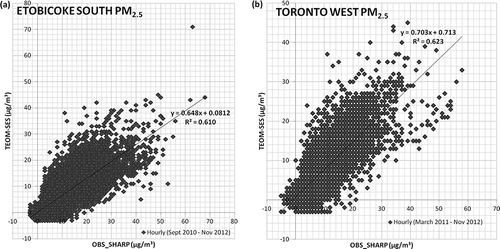
The plots in show the relationship between the transformed TEOM-SES hourly PM2.5 (i.e., MOD_SHARP) and the observed SHARP values. There is a marked improvement in regression parameters m, R 2, and MSres at both locations: 0.868, 0.868, and 6.84 and 0.838, 0.838, and 7.63 at Sites A and B, respectively.
Figure 3. Transformed TEOM-SES hourly PM2.5 concentrations plotted against the corresponding observed SHARP 5030 values at (a) Site A and (b) Site B.
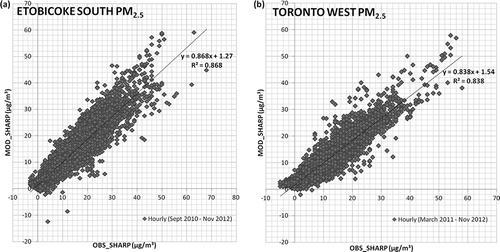
The mean values of MLR coefficients at Sites A and B are given in eq 2. Mean values for six of the nine independent regressors fell outside the corresponding confidence intervals for Etobicoke South but three regressors were very close to their upper/lower limits. None of the regressors had a percent difference ≥100%. This gives an indication of the robustness of the coefficients obtained independently from the two sites.
This transformation applies to 8 out of 42 stations where both TEOM and SHARP instruments will be collocated in the province. The transformation of historical TEOM data at all 42 stations, mainly for transforming TEOM-SES data when/where SHARP was not collocated, is discussed in more detail below.
MLRA parameters for transformations of historical TEOM-SES PM2.5 values
Regression of all the hourly SHARP data against the TEOM data and other relevant variables (see the Multiple Linear Regression Analyses subsection above) revealed that all available five independent variables were significant at the chosen confidence level. There is no improvement in MLRA parameters (m, R 2, and MSres) at both sites using these five variables at Site A (0.654, 0.654, 17.9) and Site B (0.647, 0.647, 16.5) for all the data. Also, four of the independent variables had MLRA coefficients that had percent differences greater than 100% with respect to values from Site A, indicating very different values from both sites; thus, the data were sectioned into four seasons. In this study, winter was defined as December 1 to February 28/29; spring was March 1 to May 31; summer was June 1 to August 31; and fall was September 1 to November 30.
For Site A, the regression parameters (m, R 2, MSres) for all four seasons are given in for the originally observed TEOM-SES and transformed (MOD_SHARP) data against the observed SHARP data.
Table 3. Regression parameters of originally observed and transformed hourly TEOM-SES PM2.5 against SHARP 5030 data by seasons at Site A for the period September 2010 to November 2012
The mean MLRA coefficients for the two sites were also computed except for winter, for which the regression was only computed at Site A because the ambient temperature values were missing due to a systems failure at Site B during winter. Most of the mean values (shown in parenthesis in ) fell within the confidence interval for coefficients from Site A and the percent difference never exceeded 100%.
As shown in , there is an improvement of two (m and R 2) of three parameters for winter and fall at Site A. The plots in and show the winter and summer regressions at Site A for the observed TEOM-SES and transformed MOD_SHARP data. The transformation of the TEOM-SES data in winter clearly improves the slope, whereas summer transformation worsens it. The marginal gain in the proportion of variance explained by the regression, i.e., R 2 cannot justify the unacceptable reduction in the slope for spring and summer (). Thus, there is no value to transforming the TEOM-SES data in spring and summer. This finding suggests that TEOM-SES in summer most closely behaves like a true FEM compared with colder months when loss of semivolatile components of PM2.5 necessitates that a transformation be considered. We speculate that this is most likely related to the cold temperature dependency of the formation of semivolatile particulate ammonium nitrate, a process that is most favorable in winter and least so in summer. Thus, in winter, TEOM-SES operated at 30 °C may be “flashing off” significant portions of the ammonium nitrate component of the particulate matter. In summer, ambient temperature is not a significant variable to the relationship between the TEOM-SES and SHARP data. This may indicate that temperature-dependent formation and loss processes are less important during this time. In general, the variables used in the summer MLRA are not critical to improving linearity (even though the ANOVA partitions a marginally higher R 2 value to the MLRA model), because the original slope m (0.932) of PM2.5 measurements from both instruments approaches unity; thus, there is no need for a summertime transformation.
Determining the relative importance of variables used in the seasonal MLRA
Not all independent variables initially included in the MLRA may be needed to obtain the modeled data (i.e., MOD_SHARP). This problem was addressed by using a backward-elimination approach, which filters out insignificant variables based on the desired confidence level in the MLRA. This has practical implications when a limited number of operational variables are available for the analyses. Optionally, an additional filtering technique comprising a normal distribution plot of ranked Z-scores () can be used to further assess the significance of each variable MLRA coefficient (with the exception of the constant β0). This plot is obtained by plotting each regressor's standard normal deviate (Z-score) on the x-axis, where
μ is the mean of the regression coefficients and σ is their standard deviation. The estimated probability attributable to the plotting positions for their ranks (y-axis) can be obtained by ordering the regression coefficients from smallest to largest and applying the ranking formula:
Figure 6. Normal distribution plots of the Z-scores of the variable coefficients obtained from MLRA of (a) winter, (b) spring, (c) summer, and (d) fall PM2.5 data at Site A and Site B during the study period. Shelter temperature in winter and sample relative humidity in spring may be neglected from the MLRA.
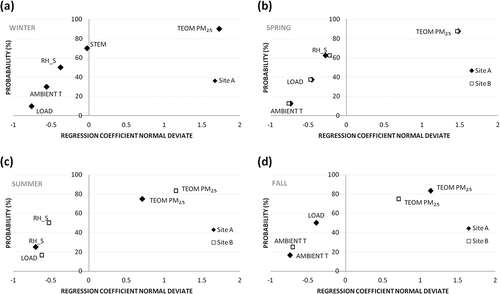
The significance of ambient temperature to the TEOM-SHARP relationships is in line with previous findings that the TEOM-SES (30 °C) may underreport PM2.5 mass, especially in winter, due to the loss of semivolatile components (CitationEnvironmental Monitoring and Reporting Branch, Ontario Ministry of the Environment, 2013). On the other hand, the shelter temperature (STEM) variable in winter () lies close to the zero value of the x-axis and may be neglected from the MLRA for winter. This also holds for the TEOM-based sample RH (RH_S) in spring (). In winter, it appears that the shelter heating system at Site A has some success in keeping the STEM fairly constant, thus reducing the overall importance of its Z-score. The other variables (e.g., relative humidity, TEOM loading, etc.) may also contribute to the variance between TEOM-SES and “SHARP-like” PM2.5 measurements in the other seasons. Although the RH_S and LOAD variable terms can be found in the MLRA equations for spring and summer, other factors not monitored in this study may be more important for improving the slope between the original TEOM-SES and transformed data. Further investigations are needed to potentially identify these other factors and to fully understand the importance of the variables that were available.
Applicability of winter and fall transformation parameters across Ontario
Further validation of the MLRA-transformed TEOM-SES data (i.e., MOD_SHARP) was done by comparing them with concentrations obtained from 24-hr FRM samplers at the locations where both TEOM-SES and FRM instruments are collocated in the province (). These locations span three degrees of latitude from Windsor to Ottawa so the improved linearization of TEOM-SES data with the FRM data upon transformation of the TEOM-SES data obtained over a wide geographical extent can be used as a performance benchmark for the MLRA transformation coefficients developed from two sites within the province.
Hourly TEOM-SES data from these seven sites (Environment Canada, 2013) for all winter and fall days that had the relevant associated variables were transformed using the relevant seasonal coefficients in and averaged over 24 hr with the requirement that at least 18 hr must be available to constitute a valid sample for comparisons with FRM measurements. Regression parameters for winter and fall are given in and and , show how the averaged originally observed (TEOM-SES_24h_AVG) and transformed (MOD_SHARP_24h_ AVG) data compare with the FRM at Etobicoke South (Site A), Ottawa, and Windsor in winter and fall, respectively.
Figure 7. Winter comparisons of the 24-hr-averaged original (gray diamonds) and transformed (black squares) TEOM-SES PM2.5 values against the NAPS 24-hr FRM at (a) Etobicoke South research station (Site A), (b) Ottawa Downtown, and (c) Windsor West.

Table 4. Parameters of linear regression of originally observed and transformed TEOM-SES PM2.5 data against the 24-hr NAPS FRM values across seven air monitoring locations in Ontario for FRM data collected since 2005
It is clear from and that the slopes m of the winter TEOM-SES/FRM relationships experience a significant increase and better approach unity upon transformation. Ottawa had the highest transformed slope (1.032), whereas Site B had the lowest m (0.739) in comparison with original slopes 0.671 and 0.478, respectively.
The other five locations had transformed winter slopes that ranged between 0.831 (Hamilton) and 0.915 (Site A). The change in coefficient of determination R 2 ranged from a 3.5% decrease at Site B (0.810 to 0.782) to an 8.3% improvement at Windsor (0.737 to 0.798) upon transformation. The other sites had essentially unchanged R 2 values, which ranged from 0.848 (Hamilton) to 0.929 (Site A) after transformation.
In fall, the change in slope upon transformation of the TEOM-SES data was not as prominent as with winter, with the exception of Hamilton (0.895 to 0.976). R 2 were essentially ≥0.9 after transformation with the exception of Ottawa (0.865) and Site B (0.875).
A simple comparison was made among the 24-hr-averaged TEOM-SES (TEOM-SES_24h_AVG), the 24-hr-averaged transformed TEOM-SES (MOD_SHARP_24h_AVG), and the benchmarking FRM data to determine the number of times they exceeded 30 μg/m3; the CWS-based 2010 reference value for PM2.5 reported by the OMOE (CitationEnvironmental Monitoring and Reporting Branch, Ontario Ministry of the Environment, 2013) during the 2005–2012 period of study at all seven collocation sites in the province. shows that the transformed data yield near-identical exceedance compared with the FRM in winter, whereas the 24-hr-averaged original TEOM-SES data clearly underreport this wintertime exceedance. The transformed data severely underperform in summer and to a lesser extent in spring, indicating that there is no value to transformation with the available variables during these two seasons. In fall, the transformed data may slightly overreport the exceedance when compared with the FRM.
Figure 8. Fall comparisons of the 24-hr-averaged original (gray diamonds) and transformed (black squares) TEOM-SES PM2.5 values against the NAPS 24-hr FRM at (a) Etobicoke South research station (Site A), (b) Ottawa Downtown, and (c) Windsor West.
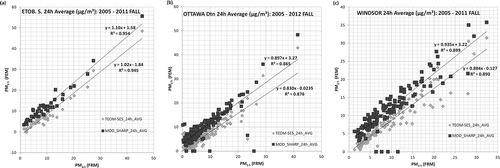
Table 5. Comparison of the number of exceedance of the 2010 PM2.5 reference level in Ontario (30 μg/m3) by 24-hr data sourced from the benchmark NAPS FRM, originally observed and transformed TEOM-SES across seven air monitoring locations in Ontario for the 2005–2012 study period
Summary
Transformation coefficients have been developed with MLRA for the cases of adjusting future and historical TEOM-SES near-real-time continuous PM2.5 measurements at two air monitoring stations within the province of Ontario to make them resemble readings from the new SHARP 5030. For adjustments of TEOM data to be collected in the future, i.e., at those few sites where TEOM instruments will be collocated with SHARP monitors, the inclusion of operational parameters of physicochemical relevance in the MLRA across the TEOM and SHARP instruments resulted in transformed TEOM-SES measurements that gave an average 25% improvement in the slope against SHARP measurements over the original data when all the data were included in a single-model MLRA at each site.
For adjustments of historical TEOM data, the data had to be sectioned into seasons to obtain meaningful transformations. At Site A, a 55% improvement in the slope against the corresponding SHARP data was observed over winter and 9.4% improvement in fall with the seasonal MLRA transformation models, whereas at Site B, a 13.3% improvement in slope was observed in fall.
Applicability of the “historical” MLRA parameters for winter and fall developed at these two sites to the entire province was gauged by comparing the “SHARP-like” transformed TEOM-SES data to the 24-hr NAPS FRM values collected at seven stations where both instrumental measurement methods (TEOM-SES and FRM) were collocated. On average at these seven air monitoring stations, a 58% increase in slope over the original measurements was observed in winter and 7% increase in fall. Although these parameters may be specific to Ontario, the MLRA method described for the “SHARP-like” transformation of TEOM data is widely applicable anywhere by taking the following practical steps:
| • | collocation of TEOM and FEM-based instruments for a study period ≥1 yr to capture as much ambient temporal variations as possible; | ||||
| • | polling hourly PM2.5 and other relevant operational parameters such as temperature, relative humidity, etc.; | ||||
| • | MLRA of all the hourly data to determine significance of variables and the improvement, if any, of regression parameters (m, R 2, and MSres) over the untransformed TEOM data when both are compared with the FEM data; | ||||
| • | fine-tuning the MLRA by sectioning the hourly data into seasons if regression parameters show no improvement for all data combined (this is important for historical data transformations where fewer variables may be available); | ||||
| • | MLRA of the seasonal hourly data against the FEM (which was SHARP-based in Ontario) to obtain the transforming regression coefficients; | ||||
| • | determining the relative importance of the MLRA coefficients by creating a normal distribution plot for their ranks and normal standard deviates (this step is optional); and | ||||
| • | comparing the 24-hr-averaged transformed data with the FRM where available. | ||||
Acknowledgment
The authors gratefully acknowledge the Canadian National Atmospheric Chemistry (NAtChem) Particulate Matter Database and its data-contributing agencies for the provision of data for 2005–2012 used in this paper. The agencies responsible for data contributions in 2005–2012 to the NAtChem/Particulate Matter Database include Environment Canada National Air Pollution Surveillance Network.
Supplemental Data
Supplemental data for this article can be accessed on the publisher's website http://dx.doi.org/10.1080/10962247.2013.833145.
Supplementary Material.docx
Download MS Word (5.8 MB)References
- Canadian Council of Ministers of the Environment . 2011 . Ambient Air Monitoring Protocol for PM2.5 and Ozone. Canada-Wide Standards for Particulate Matter and Ozone http://www.ec.gc.ca/natchem/default.asp?lang=En&n=2E5B9E92-1. Winnipeg, Manitoba, Canada: Canadian Council of Ministers of the Environment.
- Dabek-Zlotorzynska , E. , Dann , T.F. , Martinelango , P.K. , Celo , V. , Brook , J.R. , Mathieu , D. , Ding , L. and Austin. , C.C. 2011 . Canadian National Air Pollution Surveillance (NAPS) PM2.5 Speciation Program: Methodology and PM2.5 chemical composition for the years 2003–2008 . Atmos. Environ , 45 : 673 – 686 . doi: 10.1016/j.atmosenv.2010.10.024.
- “ Environment Canada. xxxx ” . In Canadian National Atmospheric Chemistry Particulate Matter Database (22/11/2010, 27/01/2012, 18/04/2012) , Toronto : Environment Canada, Science and Technology Branch .
- Environmental Monitoring and Reporting Branch, Ontario Ministry of the Environment . 2013 . “ Report for 2011. Toronto, Ontario, Canada: Ontario Ministry of the Environment ” . In Air Quality in Ontario
- Lee , J.H. , Hopke , P.K. , Holsen , T.M. , Lee , D.-W. , P.A. Jaques , Sioutas , C. and Ambs. , J.L. 2005 . Performance evaluation of continuous mass concentration monitors . J. Aerosol Sci , 36 : 95 – 109 . doi: 10.1016/j.jaerosci.2004.07.006
- Meyer , M.B. , Patashnick , H. , Ambs , J.L. and Rupprecht. , E. 2000 . Development of a sample equilibration system for the TEOM continuous PM monitor . J. Air Waste Manage. Assoc , 50 : 1345 – 1349 . doi: 10.1080/10473289.2000.10464180
- Patashnick , H. and Rupprecht. , E.G. 1991 . Continuous PM-10 measurements using the tapered element oscillating microbalance . J. Air Waste Manage. Assoc , 41 : 1079 – 1083 . doi: 10.1080/10473289.1991.10466903
- Rizzo , M. , Scheff , P.A. and Kaldy. , W. 2003 . Adjusting tapered element oscillating microbalance data for comparison with Federal Reference Method PM2.5 measurements in Region 5 . J. Air Waste Manage. Assoc , 53 : 596 – 607 . doi: 10.1080/10473289.2003.10466196
- Thermo Fisher Scientific Inc . 2007 . Model 5030. Instruction Manual. Synchronized Hybrid Ambient Real-Time Particulate Monitor , Franklin : MA: Thermo Fisher Scientific Inc. Air Quality Instruments .
- Tortajada-Genaro , L. and Borras. , E. 2011 . Temperature effect of tapered element oscillating microbalance (TEOM) system measuring semi-volatile organic particulate matter . J. Environ. Monit , 13 : 1017 – 1026 . doi: 10.1039/C0EM00451K
- U.S. Environmental Protection Agency . 1997a . “ 40 CFR Part 50. National Ambient Air Quality Standards for Particulate Matter; Final Rule ” . In Prepublication Vol. 62 , Vol.
- U.S. Environmental Protection Agency . 1997b . “ 40 CFR Parts 53 and 58. Revised Requirements for Designation of Reference and Equivalent Methods for PM2.5 and Ambient Air Quality Surveillance for Particulate Matter; Final Rule ” . In Prepublication Vol. 62 , Vol
- U.S. Environmental Protection Agency. 2011. List of designated reference and equivalent methods. Last modified October 12, 2011accessed January 20, 2012). http://www.epa.gov/ttn/amtic/criteria.html (http://www.epa.gov/ttn/amtic/criteria.html)
- Zhu , K. , Zhang , J. and Lioy. , P.J. 2007 . Evaluation and comparison of continuous fine particulate matter monitors for measurement of ambient aerosols . J. Air Waste Manage. Assoc , 57 : 1499 – 1506 . doi: 10.3155/1047-3289.57.12.1499

